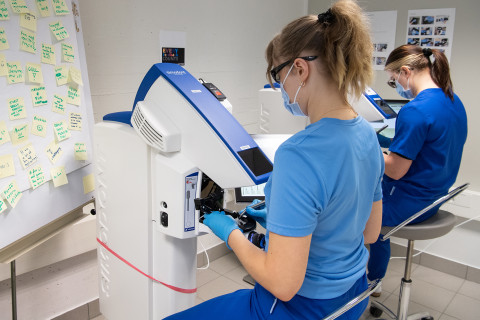Combining VR haptics with conventional tooth preparation exercises in dental education, , it is possible to improve students’ learning outcomes, according to a new study carried out at the Institute of Dentistry, University of Eastern Finland. In addition, students felt that their self-confidence improved after practicing in the VR haptic environment. The yet unpublished results were presented at the AMEF conference 2023 in Helsinki.
Preclinical dental education traditionally utilises well-proven phantom head-based teaching methods. The use of haptics-enhanced virtual reality (VR haptics) has become more prevalent in dental education in the past decade. Thus, there is quite a bit of discourse over VR haptic equipment, such as the Simodont Dental Trainers, in particular about the additional value they bring in educational settings. However, less than 150 dental institutions worldwide have had this equipment installed. Factors that slow down adoption include financial matters, such as lacking allocatable installation space and personnel. There is a need for expert dentists and dental educators with interest in developing scientific evidence-based curricula to utilise VR haptic equipment.
Combining VR haptics with traditional phantom head practice, and the supportive effect they have on each other, remains under-researched. Finland’s first VR-haptic Simodont Dental Trainers were installed at the University of Eastern Finland in 2021. “After getting the equipment, we immediately decided to begin researching their use,” Clinical Lecturer Outi Huhtela says.
Understanding tooth preparation techniques and the quality of work have an important role in preclinical dental education. Working with equipment that does not require the destruction of physical resource, such as acrylic tooth models, is a welcome almost-independent practice method for students. Additionally, the machine gives continuous objective feedback on students’ performances, which is useful for students and educators alike.
A more casual setting for exercises
The new study presented showcases the use of VR haptic equipment in the execution of a preclinical dental course and assesses students’ performances and personal views on it.
The main research questions were whether VR haptic teaching equipment enhances phantom head practice while supporting learning, and whether it is possible to improve manual dexterity by utilising a virtual learning environment.
Forty preclinical stage dental students were split into two groups to practice the preparation of a tooth for a dental crown. Group A began the course by practicing with a VR haptic trainer, whereas Group B started working with plastic teeth. Halfway through the course, the groups swapped places. The VR haptic trainer was used to practice drilling by working on simple geometric shapes as well as preparing a tooth pillar for a ceramic crown. At the end of the course, the students prepared a dental crown while aiming to stay within given clinical parameters. Data of the students’ performances was gathered with both the inbuilt methods of the VR-haptic equipment and via imaging-based measurements. Additionally, the opinions and feelings of the students were assessed through anonymous voluntary surveys.
At first, the students found the use of VR haptic equipment challenging, but after encouragement the results were promising. The majority said that they appreciated the practicality of the exercises and the information given by the equipment. Over two-thirds of the students felt that their self-confidence improved after practicing in the VR haptic environment. VR haptic practice was considered useful in improving manual dexterity and preparing for upcoming courses. However, only a small share of the respondents felt that VR haptic training could completely replace working with a phantom head.
Clinical measurements of the tooth preparations completed for the final exam were found to be more even and closer to ideal in Group A than Group B. There was also less damage to the neighbouring teeth in Group A. There were no differences in the baseline measurements between the groups.
“We found dental practice that combined VR haptics and Frasaco plastic tooth model preparation exercises to be a good method to reach the required level of skill for the preparation of a tooth crown. The benefits of VR haptic practice especially include its relative casualness, the ability to try again as many times as necessary, and the possibility of training at a time suitable for each student. There is still a need for more research so that VR haptics could be used as a primary method of learning in preclinical education and in assessing students’ performances,” University Teacher Szabolcs Felszeghy says.
For further information, please contact:
Clinical lecturer Outi Huhtela, https://uefconnect.uef.fi/en/person/outi.huhtela/
Professor Murat Mutluay, https://uefconnect.uef.fi/en/person/murat.mutluay/
University Teacher Szabolcs Felszeghy, https://uefconnect.uef.fi/en/person/szabolcs.felszeghy/
Watch a video summary of the study:



